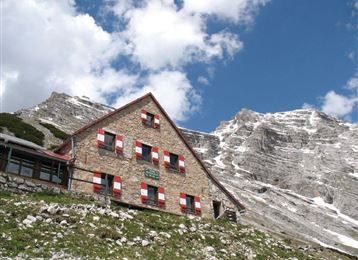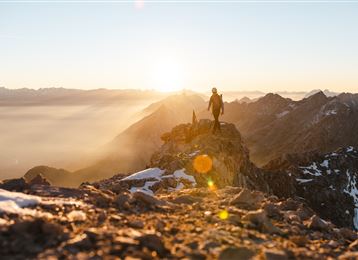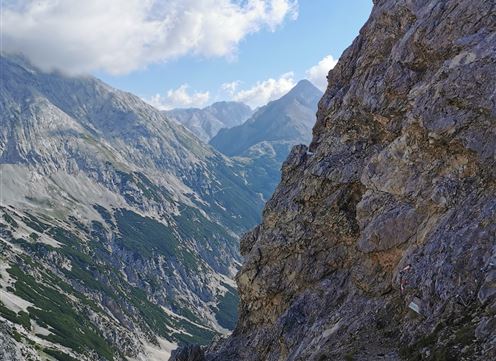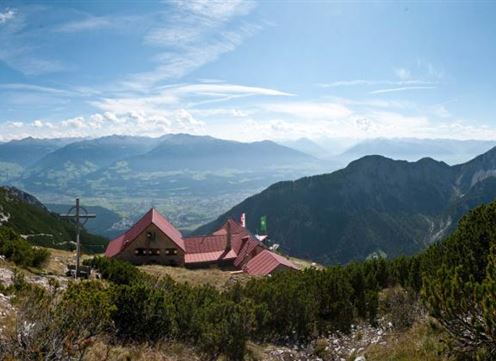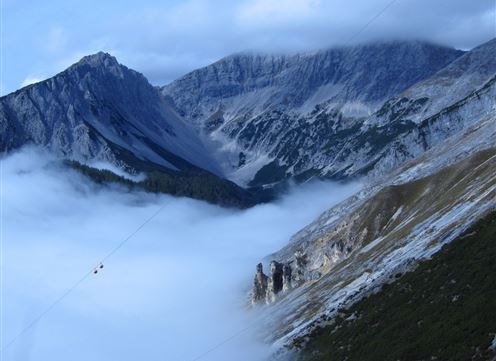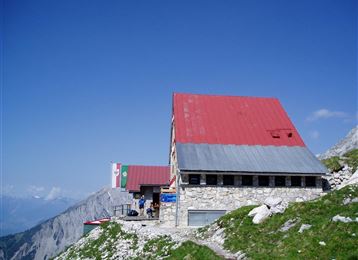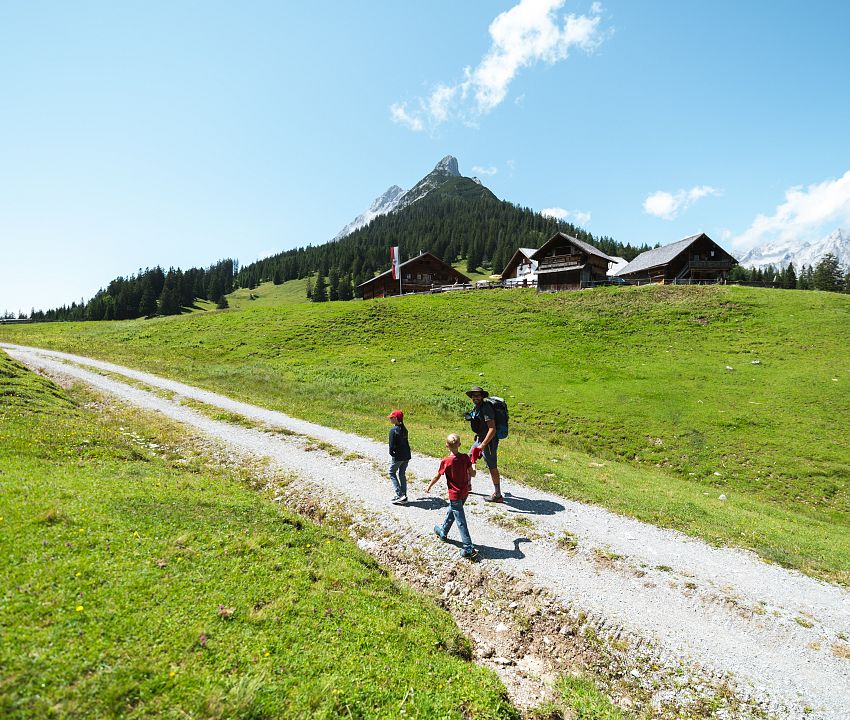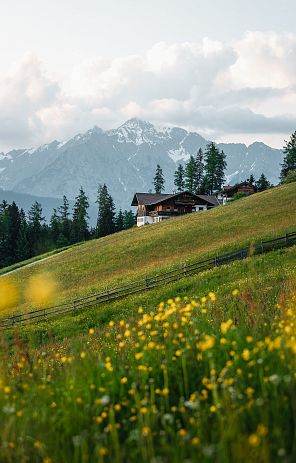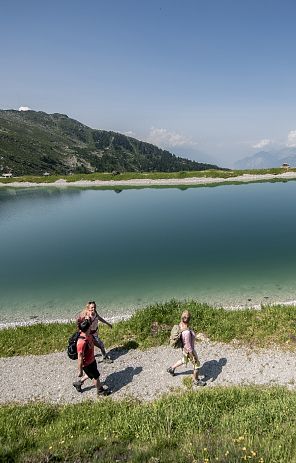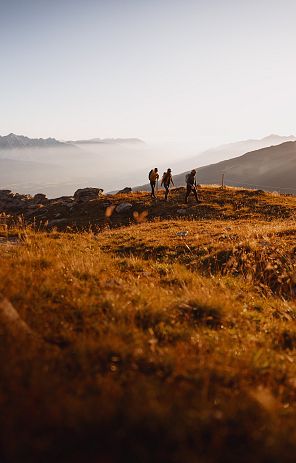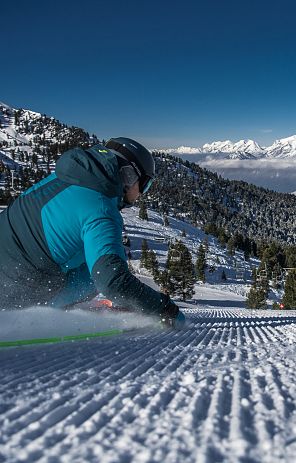Powerful Place. Bettelwurf in the Karwendel Mountains
The Bettelwurf is striking and instantly recognizable in the middle of the Karwendel mountains: an icon of limestone and rock
It is the greatest power place of all, the most powerful. Also the most impressive. A stone colossus, over 2700 meters high. One of the mightiest peaks in the Karwendel, and one of the most beautiful - the legendary Bettelwurf!
Its beauty has even won an award: on the occasion of its 150th anniversary, sports outfitter Mammut selected the 150 most beautiful peaks in the world, including the Bettelwurf, alongside mountain icons such as the Grossglockner or the Wilder Kaiser.
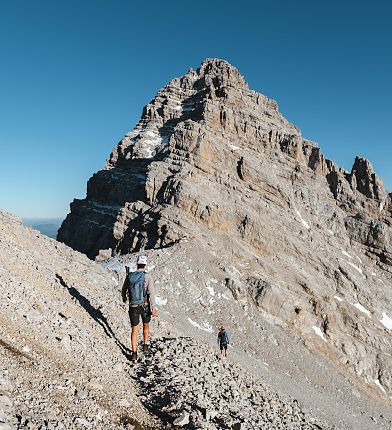
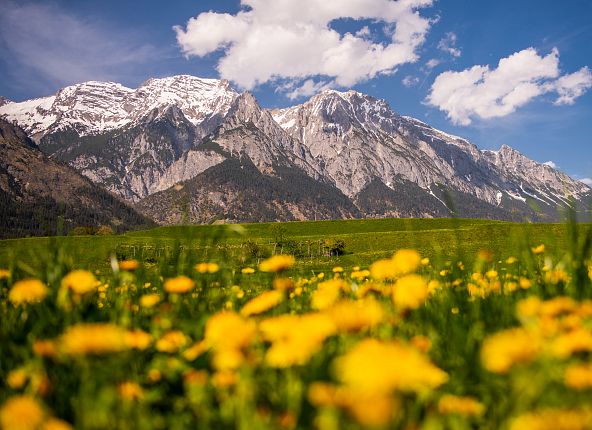
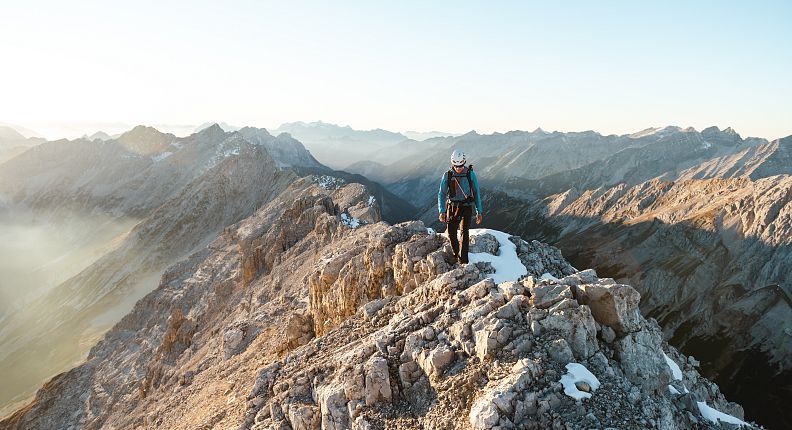
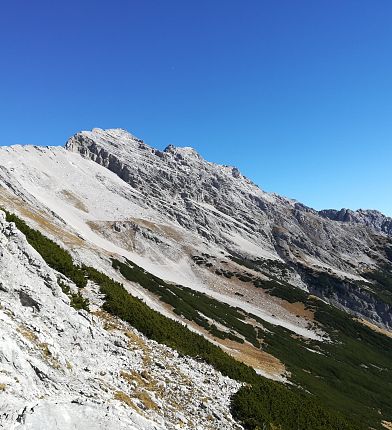
Not that the begging throw counts in beauty contests: Its mightiness is too sublime, too grand. Always a little shrouded in mystery. The legend of the Bettelwurf spirit, which has been told in the Karwendel region for centuries, fits in perfectly.
At the drinking water tunnel, an ascent path branches off to the Bettelwurfhütte and the Bettelwurf. It leads steeply uphill, the views are breathtaking, it remains unforgettable and can be addictive. The mountaineer Carl Gsaller laid out this route as early as 1881, but the trail was finally extended when the Bettelwurfhütte was built in 1894 and is still the same today as it was then. The Große Bettelwurf is the fourth highest Karwendel peak after the Birkkarspitze, the Ödkarspitze and the Kaltwasserkarspitze, but the highest peak in the Halltal chain.
Immerse yourself in a truly sublime place of power!
The Bettelwurf power place in the Karwendel mountains at a glance
- Halltal and its history
- Karwendel Nature Park
- Legend of the begging spirit
- Beggar's hut
- Wild Band
- Drinking water
- Shuttleservice Halltal
How do you get to the begging litter?
Even apart from legends and myths, the Bettelwurf is a special place whose power can be felt with every step. Various challenging mountain trails and a via ferrata lead to the summit. When you stand up there, at lofty heights, looking far into the Inn Valley and as far as Bavaria, you realize that this is a place of power in its purest form.
Please note: A head for heights, sure-footedness and alpine experience are essential for this tour!!!
Overview
There are various approaches to get to the Bettelwurf. For the shortest option, take the cab shuttle from the parking lot at the entrance to Halltal (also easily accessible by public transport) to the drinking water tunnel in Halltal (1000 m), from there it is approx. 2.5 h (1077 m) to Bettelwurfhütte and then another 1.5 h (680 m) on partly wire-insured paths to the summit.
Detail
You need to be sure-footed and have a head for heights for this tour! The starting point is the parking lot at the entrance to Halltal in Absam. Hike either along the road or left along the path to the drinking water tunnel. Cross the stream and follow the signs for "Bettelwurfhütte". The ascent up the gravel field is strenuous, you cross to the left and come to a path through mountain pines. After a while, you will reach the "Bettelwurfhütte" or "Gr Bettelwurf" turn-off. If you want to stop for a break or rest, you can walk directly from the hut in the direction of Eisengattergrat. This is a challenging climb, the upper part of which is well secured with wires to the Großer Bettelwurf! A unique summit victory! Return via the same route. As this is a very long tour, you should consider planning an overnight stay at the Bettelwurfhütte!
Total duration: approx. 4 h/approx. 1750 hm.
The first ascent of the Großer Bettelwurf
Compared to other Karwendel peaks, the Bettelwurf was visited by urban tourists relatively early on due to its proximity to the Inn Valley. Although the first ascent of the summit is attributed to Hermann von Barth on June 16, 1870, the first known touriston the Grosser Bettelwurf was Ludwig Barth zu Barthenau, who was guided to the summit by a marksman around 1855. In his book "Aus den nördlichen Kalkalpen", Hermann von Barth also makes a reference to this, but describes his ascent attempt on June 15, 1870 and finally the ascent of the summit one day later.
In September 1867, Julius Pock (founder of the alpine association "Wilde Bande") and Karl Wechner reached the summit on their second attempt. On June 18, 1878, Carl Gsaller climbed the much more challenging summit of the Kleiner Bettelwurf via the south ridge for the first time and then successfully completed the ridge crossing to the Großer Bettelwurf.
Hermann von Barth - pioneer in the Karwendel
Hermann Freiherr von Barth-Harmating was born at Eurasburg Castle in 18454 and died in Sao Paulo de Luanda, Angola, in 1876. He first studied law in Munich. As a legal trainee, he began to explore the still largely unexplored Berchtesgaden Alps from 1868. From 1873 he studied natural sciences. He is best known as the explorer of the Karwendel. He later explored the Wetterstein mountains and the Allgäu Alps (see Hermann von Barth Hütte). In 1876, confused by a fever, he committed suicide on a research trip to Africa!
During his ascent of the Bettelwurf, Barth spent the night in the manor houses and climbed from there to the Lafatscherjoch. From here he traversed above the Hohe Wand through the large and small Speckkar to the Eisengattergrat. Over the ledges and ledges on the Eisengattergrat and finally through the Große Rinne, he reached the summit of the Großer Bettelwurf, where Barth found no signs of an earlier ascent. Barth looked for a place in the direction of Osteck that could be seen from St. Magdalena and erected a large cairn there. Today's normal ascent essentially follows Hermann von Barth's route, as he recorded it in a sketch of the Bettelwurf from the Hochmahdkopf opposite. After returning to the manor houses, Barth went to St. Magdalena to tell the squire Franz Posch, who lived there and was in charge of hunting, about the successful ascent and to show him the cairn on the summit through binoculars.
Source: Alpine Club Innsbruck Section
The Bettelwurfhütte: the oldest hut in the Karwendel
It's a good thing that there is a special resting place on the way to the summit of the Bettelwurf: The Bettelwurfhütte at 2077 meters above sea level. It was built in 1894, making it the oldest hut in the Karwendel. Its interior is rustic and cozy, and the innkeepers are always up for a chat. You can also spend the night here. The Bettelwurfhütte is located on a rocky shoulder directly below the Kleiner Bettelwurf and has made a decisive contribution to the value of the Halltal recreational area since it was built. Julius Pock, chairman and founder of the "Wilde Bande" Alpine Society, was also the founder of the Bettelwurfhütte.
In 1892, the Central Committee of the Alpine Association offered the prospect of significant financial resources, so that the matter got underway. The planned site was located on a small terrace on the southern ridge of the Kleiner Bettelwurf at an altitude of around 2,100 meters. The land was owned by the k.k. The land was owned by the Imperial and Royal Forestry and Domain Directorate, which agreed to the construction of a hut on the planned site and initially leased the land to the section for a period of nine years. The direct route to the hut was begun in 1892. Initially, a route of around 2,000 m was constructed, the section at the entrance to the rocks was blasted and equipped with wire ropes. Work continued in 1893 and on October 25, 1893, the path was completed as far as the planned site for the hut. At the same time, the climb up the Großer Bettelwurf was completed in 1892/93
The Bettelwurf hut itself was on display at the Tyrolean Provincial Exhibition in Innsbruck in 1893. After the end of the exhibition, all usable wooden and iron parts as well as furnishings were taken to the working hut on the Lafatscherjoch. In 1894, all the materials for building the hut were delivered from the Lafatscherjoch to the construction site. The hut was built by master builder Andrä Höß from Mieders. The opening ceremony was held on September 8, 1894 by the deputy chairman Julius Zambra with 79 participants present. The rooms in the hut were divided up as follows: on the first floor there was a living room with a cooking stove and a bedroom for 6 to 8 people, separated by Swiss stone pine paneling and used as a dormitory. A hay and blanket store was set up in the attic.
Around the turn of the century, the number of visitors to the hut had increased so much that the rooms no longer met the requirements. Further expansion work followed. After it became increasingly difficult to supply the hut via the Lafatscherjoch, the Innsbruck branch decided to build a material ropeway in 1966, which was repeatedly renewed in the following years.
In 1974, a washroom with washing facilities and two toilets were installed in one of the north-facing twin rooms in the dormitory. In 1978, a power generator consisting of a diesel engine with an attached generator was put into operation in the service building above the old hut to supply the hut with energy. In the same year, a pantry for storing food was added to the north side of the veranda between the old hut and the dormitory. Another structural measure was the relocation of the hut entrance from the weather side to the east side of the old hut. Work began in 1980 and was completed a year later. For the relocation of the hut entrance, an extension was built on the valley side of the old hut, in which an anteroom with shoe and luggage storage and a parlor for about 20 people are housed. In 1981, the radio telephone was put into operation. The hut was thus connected to the public telephone network, which made it much easier for mountain rescuers to communicate in the event of accidents and to manage the hut. The hut now also has an internet connection.
Today, the hut offers space for 62 visitors. There are 34 beds and 28 mattress dormitories. On the north side there is an emergency room with cooking and heating facilities, which offers protection in emergencies. The opening hours are always updated on the Bettelwurfhütte website.
Source: Alpenverein Innsbruck
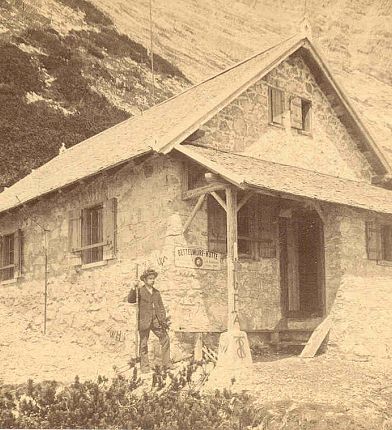
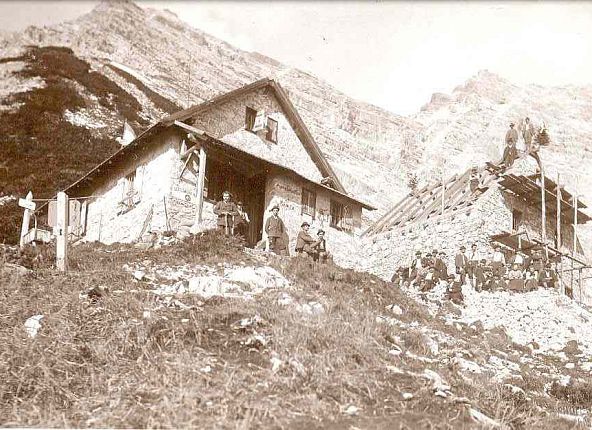
Access to the Bettelwurfhütte
- Approach A: Normal route 222 from the Halltal entrance - Bettelwurfeck - Bettelwurfhütte
- ApproachB: via St. Magdalena - Issanger - Lafatscherjoch - Bettelwurfhütte
- ApproachC: Absamer via ferrata with difficulty level A-C
- Approach D: Hafelekar - Pfeishütte - Stempeljoch - Lafatscherjoch - Bettelwurfhütte
- ApproachE: Scharnitz - Hallerangerhaus - Lafatscherjoch - Bettelwurfhütte
The legend of the beggar spirit
The origin of the name "Bettelwurf", which has yet to be unraveled, is explained by the legend of the "Bettelwurfgeist". The Absam artist Karl Obleitner has also depicted it on the manor houses:
According to legend, nuns moved into the monastery building at St. Magdalena many hundreds of years ago. However, they were not all pious and kind. One day, a poor salt miner came to the convent gate and asked for alms for his hungry flock of children. Disgruntled, the gatekeeper handed him a piece of rock-hard bread. The man was seized with rage and shouted: "You can eat this beggar yourself, you cheapskates!" And with a powerful throw, he hurled the bread against the rock face. However, bread - whether hard or soft - is a gift from God that must be handled with care.
Horrified by the act, the nun shouted: "You'll have to pay for this. You will not find peace in the grave. Your spirit will have to wander restlessly in this valley." And so it came to pass. The man has never been seen since. He wanders back and forth invisibly in the rock faces of the Halltal valley. In winter he kicks up avalanches of dust, in summer he loosens mudflows from the brittle rock. On warm foehn days, you can hear its howling and raging from the crevices in the rocks. And on clear nights with a full moon, he can be seen riding through the cirques on a white chamois with golden horns.
But the nun's avarice was also punished. An earthquake in 1670 severely damaged the monastery building, and almost twenty years later it was completely destroyed by another earthquake. The rugged, steep rock against which the salt miner had thrown the hard bread, the "beggar", was henceforth known as the "beggar's throw".
According to various traditions, the unredeemed souls of nuns who once led an unrepentant life are said to roam the St. Magdalena monastery: The landlord of St. Magdalena's, who died in 1905, said that the ghosts of the nuns repeatedly robbed him of his sleep when they pattered and shuffled up and down the stairs, tried all the doors, whispered and rumbled, and when the wind carried their singing and organ playing from the church.
The Bettelwurfbrünnel: Drinking water from the Halltal
Today, the drinking water supply for Hall and Absam is secure. However, this was not the case for a long time, as mudslides and avalanches repeatedly damaged the original spring taps at the foot of the Bettelwurfreise. After an emergency on July 31, 1992, when a huge mudslide buried several springs in the Halltal valley, the communities of Hall and Absam decided to build a new tunnel together: the Margarethen tunnel.
This tunnel is named after the tunnel's godmother Margarete Posch, the wife of the former mayor of Hall, Dr. Josef Posch. The Margarethen tunnel leads almost one kilometer into the Karwendel massif and was built between 1995 and 2002. Between 250 and 450 liters of clear and pure spring water flow out of the tunnel every second. You can see this for yourself at the Bettelwurfbrünnel. The precious water is naturally filtered by the mountain for ten years.
The Bettelwurferin: Avalanches and mudflows in the Halltal valley
If you stand at the Bettelwurfeck and look up to the right, you can see the path of the "Bettelwurferin", one of the largest avalanches in the Halltal valley. This gravel gully is also notorious and feared as a mudslide during major storms, as it has caused serious damage to the road and drinking water supply on several occasions.
The avalanche winter of 1999 severely damaged the manor houses at the end of the valley and now it faces an undetermined fate.
Despite its short length of around 6 km, the Halltal is one of the most remarkable and diverse valleys in the northern Limestone Alps. Its special features are closely linked to the complicated rock structure. Because of its interesting mixture of flora and its richness of species, the Halltal has long been the destination of important botanists. Due to the constant battle against the forces of nature and avalanches, many trees have taken on a form of their own. Birches, beeches and pines in particular have developed an elastic, stunted dwarf form; they do not break, they give way and survive.
Everywhere in the Halltal valley we find traces of huge catastrophes. A major fault has created the Bettelwurfreisen and the spring horizon there. Avalanches of old and new snow fall so regularly from the smooth Wetterstein limestone slabs and scree slopes between Lafatscherjoch and Bettelwurf that they have special names, such as the Plattnerin or the Bettelwurferin, which have so often buried the stream and the road. For this reason, the so-called "Fluchtsteig" (escape route) was created, which made it possible for the miners in the salt mine at the time to ascend and descend in relative safety. In the few avalanche-safe slopes and valleys, however, there are often only small but interesting remnants of natural forest. One of these can be found directly at the entrance to the Bettelwurf, at the 2nd Ladhütte: here you will find an older, near-natural mixed forest dominated by beech trees with lush regrowth of beech, maple, fir, spruce, Eigen and many shrub species.
Countless reports of avalanche accidents, severe weather disasters with fatalities and damage to bridges, paths, buildings and mining facilities have been handed down to us.
In 1518, Emperor Maximilian's life was endangered by an avalanche on the Wildanger, and he was supposedly only saved by the speed of his horse. At the Bettelwurfbrunnen fountain, 5 crosses with the initials of miners who died in an accident in 1565 are carved into the rock.
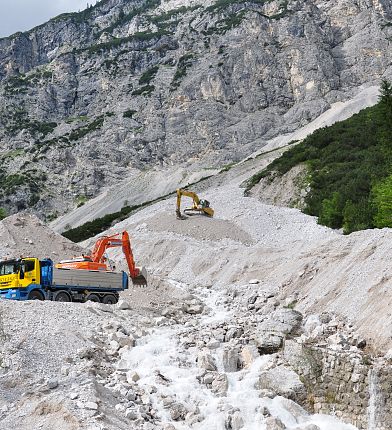
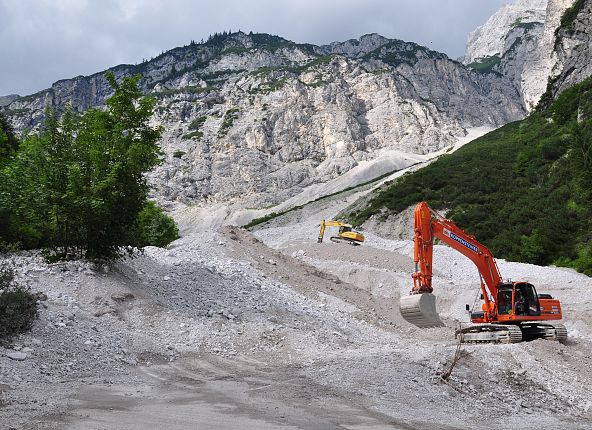
One of the most beautiful peaks in the world
To mark its 150th birthday, sports outfitter Mammut chose the 150 most beautiful peaks in the world. The mountain sports company also came up with a real Mammut project: In 2012, its 150th birthday year, around 1400 alpinists in 40 countries will climb the 150 most beautiful mountains in the world, including spectacular 8000-meter majesties such as Mount Everest.
A striking peak in the Hall-Wattens region is also represented in this list of the most beautiful mountains: Our place of power, the Große Bettelwurf in the Karwendel, is one of the world's most beautiful mountains.
The winning peaks were climbed by selected teams as part of the worldwide birthday celebrations: The ascent of the Grosser Bettelwurf in the Karwendel mountains was on the program, as was that of the Wildspitze in the Ötztal Alps, the Kellerjoch in the Tux Alps, the Wilder Kaiser in the Northern Limestone Alps between Kufstein and St. Johann in Tyrol, the Serles in the Stubai Alps, the Similaun on the Schnalskamm on the border with South Tyrol, the Große Ochsenwand in the limestone hills of the Schlick, the glaciated Weißkugel in the Ötztal Alps, the Zugspitze in the Wetterstein mountains and the Hochvogel and Mädelegabel, which lie on the border with Bavaria. Austria's highest mountain, the Grossglockner with its 3798 m on the border between East Tyrol and Carinthia, was also included.
What guidelines did the expert jury use to decide on the 150 most beautiful peaks in the world?
Does a mountain beauty contest also depend on the dimensions? Yes, because an established mountain needs a minimum height, otherwise it would just be a hill. But the decisive factor is the overall experience it offers. From the valley, you can recognize its shape and composition, its character is revealed on the more or less demanding ascent, its hospitality when you stop off at the huts, and you can enjoy the view at the top.
Many hikers and mountaineers in the Karwendel have long sworn by the unmistakable overall experience of tours to the Kleiner and Großer Bettelwurf and have long taken these striking peaks to their hearts.
